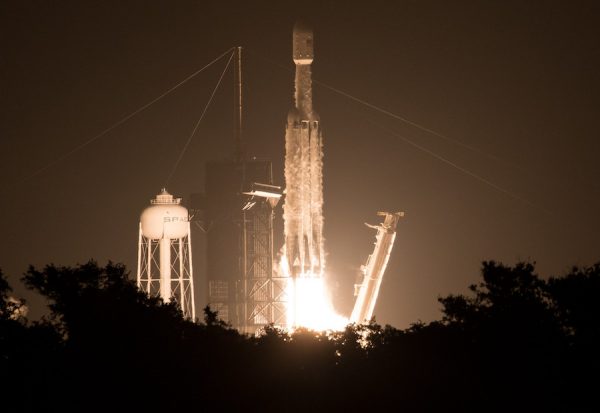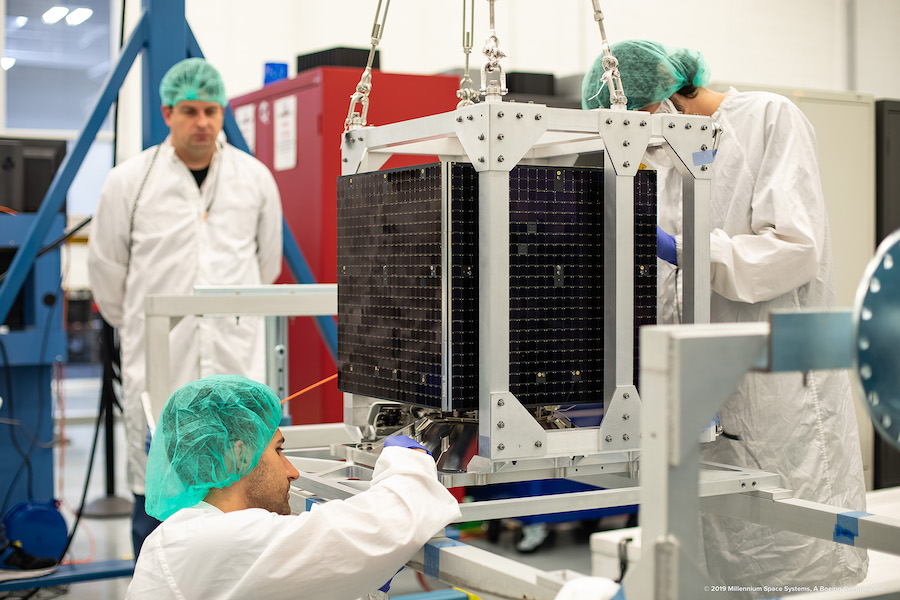Falcon Heavy set for design validation milestone before late 2020 launch – Spaceflight Now

The U.S. Space Force expects to complete design validation on SpaceX’s Falcon Heavy rocket by July, ahead of the launch of the military’s first high-priority national security mission on the heavy-lifter late this year.
The launch of multiple military payloads to an orbit more than 20,000 miles above Earth will mark the fourth flight of a SpaceX Falcon Heavy rocket, the most powerful launcher currently flying anywhere in the world.
The mission is designated USSF-44, renamed from AFSPC-44 after the establishment of the U.S. Space Force in December.
SpaceX won a military contract in February 2019 to launch the USSF-44 mission from pad 39A at NASA’s Kennedy Space Center in Florida. In documents published by the military during the procurement process, the Space and Missile Systems Center, or SMC — then part of the Air Force — suggested the USSF-44 launch will loft two payloads into a circular geosynchronous orbit more than 22,000 miles above the equator.
In the request for proposals for the USSF-44 launch, the Air Force told prospective launch providers to assume the combined mass of the two payloads is less than 8,200 pounds, or about 3.7 metric tons.
A direct injection of the USSF-44 satellites into geosynchronous orbit by the Falcon Heavy rocket will require a lengthy coast phase of more than five hours between upper stage engine burns. On the most recent Falcon Heavy mission, which lifted off last June, the rocket’s upper stage completed four burns over three-and-a-half hours on a demonstration flight sponsored by the Air Force.
The complex orbital maneuvers during last June’s mission were required to place 24 satellite payloads into three distinct orbits. They also exercised the capabilities of the Falcon Heavy and its Merlin upper stage engine before the Air Force entrusts the launcher with more critical, and more expensive, operational national security payloads on future flights.
Col. Robert Bongiovi, head of the launch enterprise division at SMC, said last week that the military certified the Falcon Heavy for national security satellite launches in June 2018 after SpaceX completed “sufficient Non-Recurring Design Validation (NRDV) activities to give the SMC commander confidence in their ability to complete their work and meet NSS (National Security Space) launch schedule and flight readiness requirements.”
“SpaceX has since provided all the required design and qualification engineering data to enable the USSF (U.S. Space Force) team to complete remaining NRDV of the Falcon Heavy design,” Bongiovi said in response to an inquiry from Spaceflight Now. “This validation should complete in July 2020. Mission specific flightworthiness certification activities are also on track for the USSF-44 launch.”

One of the payloads assigned to launch on the USSF-44 mission is a microsatellite named TETRA 1. Built by Millennium Space Systems, a subsidiary of Boeing headquartered in El Segundo, California, the small spacecraft was designed, manufactured, assembled and integrated in less than 15 months after SMC awarded the satellite development contract.
“The pace set on TETRA 1 from contract award through readiness to launch represents what Boeing does best for our national security customers,” said Mark Cherry, vice president and general manager of Boeing Phantom Works. “Our lean Millennium team was up to the task, building and delivering a fully tested and verified satellite in record time.”
TETRA 1 is based on Millennium’s Altair satellite platform. In a statement, Millennium said TETRA 1 is the first of the company’s Altair-class satellites to be qualified for operations in geosynchronous orbit.
Bongiovi said the TETRA 1 microsatellite was created to “prototype missions and tactics, techniques and procedures in and around geosynchronous Earth orbit.”
Military officials have released no additional details about TETRA 1’s mission.
While the original procurement statement indicated two spacecraft would launch on the USSF-44 mission, the Space Force declined to release the final number of satellites assigned to the flight.
The USSF-44 mission is one of six confirmed Falcon Heavy launches in SpaceX’s backlog. Another military launch on the Falcon Heavy, designated USSF-52, is planned in early 2021. SpaceX has also secured Falcon Heavy contracts to launch a Viasat broadband communications satellite, NASA’s Psyche asteroid probe, and two cargo missions to NASA’s planned Gateway mini-space station near the moon.
All of the Falcon Heavy’s planned flights will take off from pad 39A at the Kennedy Space Center in Florida.
The Falcon Heavy is made up of three modified Falcon 9 first stage boosters connected together in a triple-core configuration. The rocket’s 27 main engines produce some 5.1 million pounds of thrust at liftoff.
Bongiovi said SpaceX will use three newly-manufactured boosters for the USSF-44 mission.
“Based on mission performance requirements, the center core will be expendable and the two side boosters intend to be recovered,” Bongiovi said.
Email the author.
Follow Stephen Clark on Twitter: @StephenClark1.






